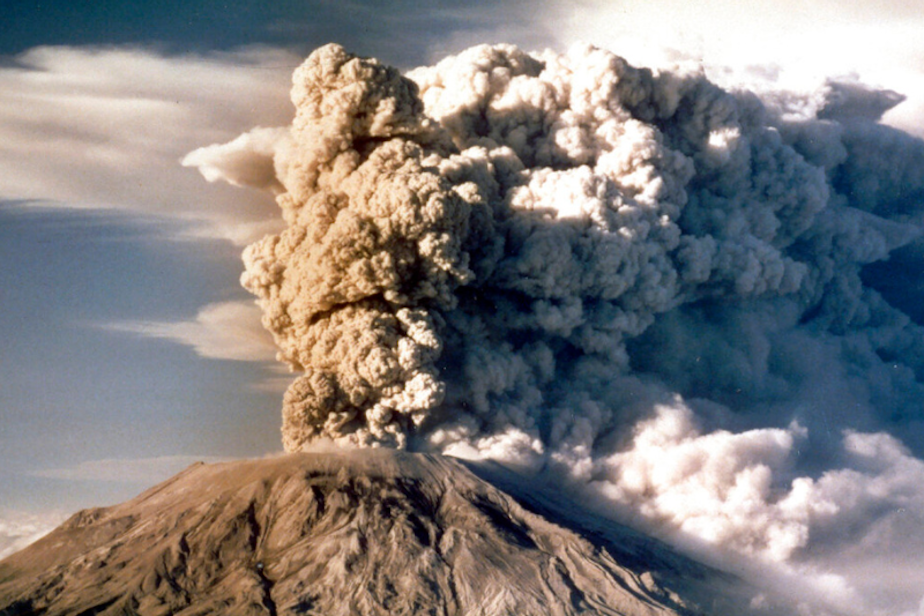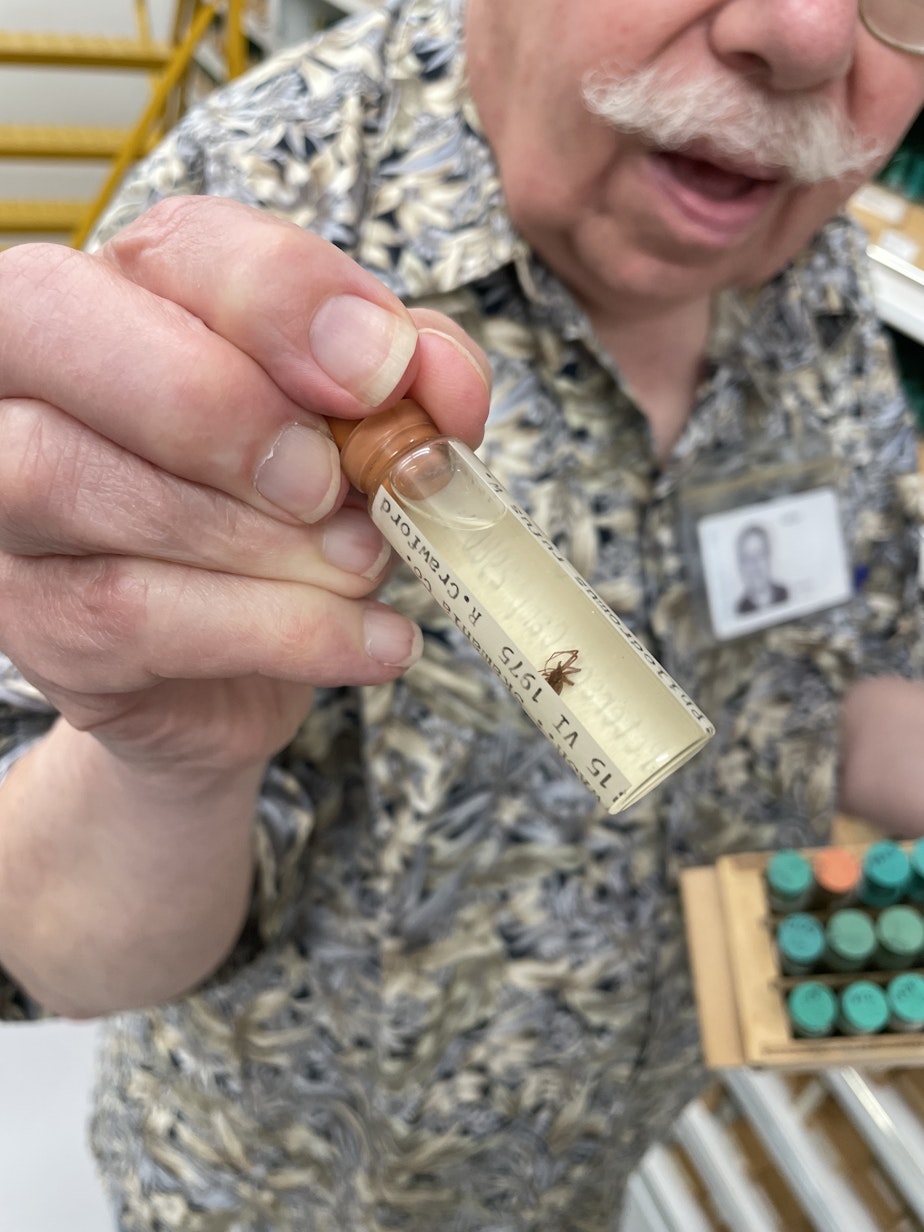What the eruption of Mount St. Helens reveals about kite-flying spiders

May 18, 2025, marks the 45th anniversary of Mount St. Helens' eruption — a catastrophic event that transformed the landscape and killed 57 people. From this devastation emerged an incredible scientific calculation about millions of spiders traveling through the sky.
On May 18, 1980, Mount St. Helens finally erupted. The volcano had been grumbling and spewing ash for months. By the end of April the actual volcano began to bulge.
A 5.1 magnitude earthquake collapsed the north flank of the mountain, which caused a debris avalanche that led to a devastating, powerful blast. The eruption would become the most destructive in U.S. history — killing 57 people, 7,000 animals, 12 million fish, causing $1 billion in damage, and spawning the largest recorded landslide on Earth.
How did a major disaster on the ground tell us about the sky? Well, in 1980 the blast from Mount St. Helens was so powerful it changed the landscape for miles — an otherworldly scene of ash and craters.
President Jimmy Carter visited and even said the aftermath site made the moon seem more like a golf course.

This grey, ash-filled landscape, known as “The Pumice Plain,” created a unique opportunity for research. No living being survived the blast in the surrounding area, so change was easier to assess.
From lupine seeds to mice — scientists from various institutions arrived to study the aftermath — including pioneer species or what newly arrived. Pioneer species are those first beings that are resilient enough to live and thrive in a new place after a disaster like a fire, flood, or volcanic blast. This attracted a team of UW biologists and zoologists interested in studying spiders
The 1980 blast was so impactful that it created a new zone for some spider species to land and attempt survival in the desolate area.
“We had a blank slate," said Rod Crawford, who studies spiders at the Burke Museum of Natural History and Culture. "We could tell what things were migrating in from a long distance away, which is something you can't very easily tell when you're in the middle of something like a forest, which already has a lot of things living there, how can you tell what's new?”
RELATED: Tooth be told: Sea otters have a powerful bite
Crawford has been preserving and studying arachnids at the Burke for decades. And he was part of the team studying spiders at the Mount St. Helens site in the years that followed the eruption.
Today, the Burke Museum has 200,000 spiders and counting in their collection. A portion of that collection is a set of super special species that landed at Mount St. Helens.

But this preservation would be years in the making.
When the volcano erupted, Crawford wasn’t even aware of what happened.
He was spending a leisurely Sunday morning at the U-District street fair, far from television or news, just strolling around looking at the various attractions.
This spider preservation project didn’t happen right away.
“ It didn't even happen that year, because first of all, a group of UW professors had to apply for a grant to the National Science Foundation. Until they got the money, they didn't do a darn thing.”
In years that followed, Crawford only managed to get into the eruption area for some cave exploration, a hobby of his at the time.
But when he finally got there, he and the team set up shop to collect their specimens. They set up all kinds of things: pitfall traps, window traps, flight traps, sticky traps, all kinds of different little gadgets, Crawford said.

From 1981-86, they caught 14,000 spiders. That’s about six spiders a day for six years until funding ran out.
And so, a spider would balloon in from miles away using the gust of wind and, “bloop!” fall into a trap filled with alcohol preserving it immediately.
These spiders were tiny. Crawford said the biggest spiders that landed – not yet adult wolf spiders – were no bigger than an M&M.
Ballooning is a dispersal technique for tiny spiders. It’s a phenomenon that scientists have known about for hundreds of years. They’ve known that tiny spiders balloon in order to find a new place to live.
“Tarantulas are a very good example of a group that cannot balloon,” Crawford said. “On the other hand, black widows belong to a group that can balloon.”
When spider eggs hatch, there can be anywhere between two eggs or hundreds of eggs at a time. And some spiders, particularly when young, evolved to be able to launch and find new homes to avoid competition with their hundreds of siblings.
RELATED: Slingshot spiders rely on good vibrations to catch supper
Spiders need optimal conditions to balloon. They check the temperature, the breeze and so on a warm day with a gentle breeze, a spider will stick out its spinnerets and throw its silk thread against the wind and wait for the thread to catch.
It's like, if spiders could fly kites, it'd be something like a spider flying itself like a kite, Crawford said.
And when spiders balloon, they can go pretty far.
“A minimum of 250 kilometers because they have been found landing on ships at sea that far out from shore,” he said.
Spiders don't get a say in where they land. They can use their legs to steer but when they pull in their silk threads, their destination is a mystery. So, none of the spiders picked the aftermath of a volcano as their destination. Ballooning is all about going with the flow — breeze.
This idea that spiders balloon was nothing new to Crawford or the team. But the eruption was so vast and devastating that it provided this unique opportunity to calculate just how many spiders could land.
The answer — millions.

There was so much wind out near Mount St. Helens because all the trees were gone. There was nothing to filter out the gentle or strong breeze.
“We know they can't thrive every place they land, but they disperse in such huge numbers that some of them are sure to find a place where they can thrive," Crawford said. "That's why we have spiders. That's why we have any living thing.”
Spider ballooning is vital for spiders. And spiders that are resilient enough to survive destruction make it possible for even more species to return and survive to the area.
As we approach the 45th anniversary of the Mount St. Helens eruption, the legacy of the event continues to unfold in scientific research. The initial scene, a devastating moonscape has transformed year over year into a recovering ecosystem and a living laboratory. The tiny spiders that floated in (and were not collected) helped rebuild the landscape and tell us a little more about nature’s resilience.
RELATED: Parenting during a pandemic and remembering when I was a kid, when Mount St. Helens erupted
The spider specimens Crawford collected are telling stories of survival, risk, and resilience after the volcano’s eruption.
The value of this collection continues with new researchers coming into the Burke to learn about the collection.
“ An army of scientists could work on this material for a thousand years without exhausting all the research that can be done on them,” he said.
Having done that research, it still needs to be kept as proof that that species was there at that time and that place.
“If you don't have the proof, then it's not science," Crawford said. "Somebody just has to take your word for it.”
Thanks to Crawford and his team, there’s proof of spiders’ resilience.
LISTEN NOW: Meet the beetles! These rice-sized workers clean up specimens at Seattle's Burke Museum





